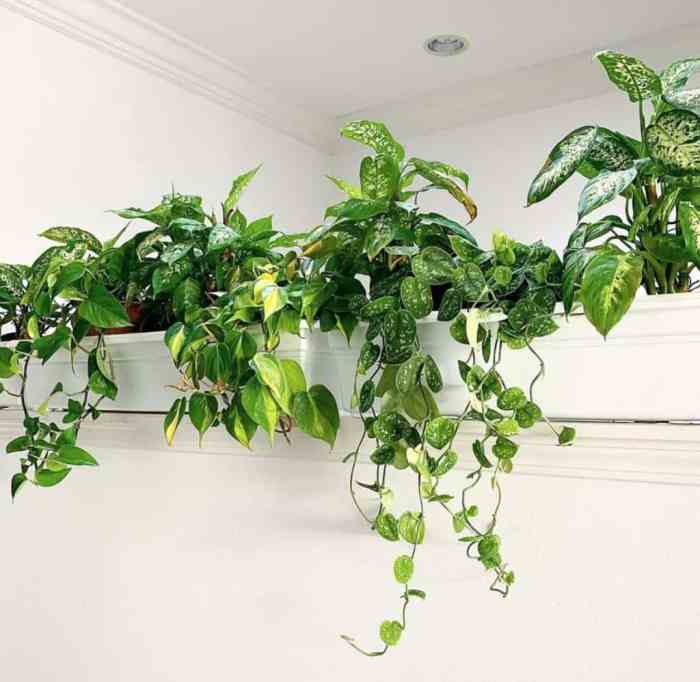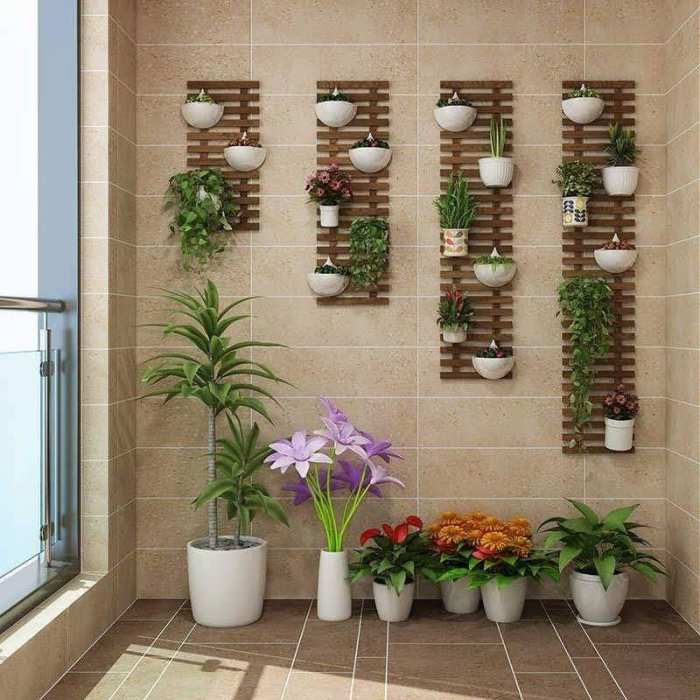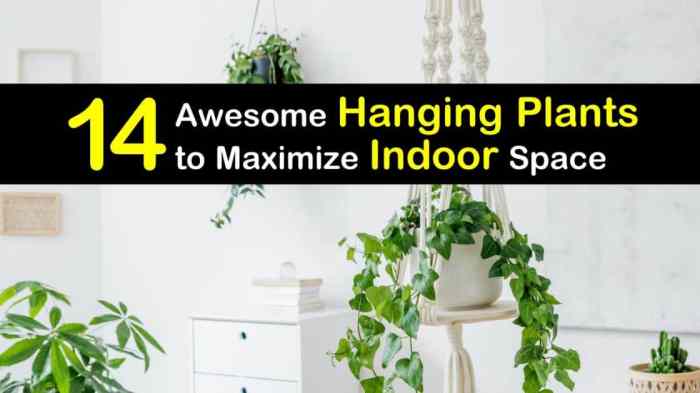Hanging live plants indoor is a transformative experience that not only beautifies your space but also promotes well-being. From improving air quality and reducing stress to adding a touch of greenery to any room, hanging plants are a versatile and impactful way to enhance your home or office.
This comprehensive guide will provide you with everything you need to know about hanging live plants indoor, from choosing the right plants and selecting the appropriate hanging system to caring for your plants and creating unique and inspiring displays.
Benefits of Hanging Live Plants Indoor

Hanging live plants indoors offers a plethora of advantages, both aesthetically and functionally. These verdant additions not only enhance the visual appeal of a space but also contribute to a healthier living environment.
Improved Air Quality
Live plants act as natural air purifiers, absorbing harmful toxins and pollutants from the air. They release oxygen and moisture, creating a fresher and more breathable atmosphere. Studies have shown that plants can effectively remove formaldehyde, benzene, and trichloroethylene, which are common indoor air pollutants.
Reduced Stress and Anxiety
The presence of live plants has been linked to reduced stress and anxiety levels. The calming effect of greenery has been observed in various settings, including offices, hospitals, and homes. Studies have demonstrated that interacting with plants can lower blood pressure, heart rate, and stress hormones.
Enhanced Aesthetics
Hanging plants add a touch of elegance and natural beauty to any indoor space. They can be used to create vertical gardens, accentuate corners, or add a pop of color to a room. The cascading foliage of hanging plants creates a sense of depth and visual interest, making them a versatile decorative element.
Suitable Plant Species for Hanging Baskets
Choosing the right plant species is crucial for successful indoor hanging gardens. Some of the most popular and low-maintenance options include:
- Pothos (Epipremnum aureum)
- Spider Plant (Chlorophytum comosum)
- String of Pearls (Senecio rowleyanus)
- Philodendron scandens
- Swedish Ivy (Plectranthus australis)
Considerations for Hanging Live Plants Indoor
When choosing hanging plants for indoor spaces, several factors must be taken into account to ensure their health and aesthetic appeal. These include:
- Light:Different plant species have varying light requirements. Consider the amount of natural light available in the room and select plants that thrive in those conditions. Plants that tolerate low light, such as pothos and spider plants, are suitable for areas with limited sunlight.
- Humidity:Some plants, like ferns and orchids, prefer high humidity levels. If the indoor air is dry, misting the plants regularly or using a humidifier can help maintain the desired humidity.
- Space:The size and shape of the hanging plant should be proportionate to the available space. Consider the height of the ceiling, the width of the window, and the distance from other objects.
Hanging Systems
The appropriate hanging system depends on the type of plant and the space available. Macrame hangers are a popular choice for small to medium-sized plants and add a bohemian touch to the decor. Wall-mounted brackets are suitable for heavier plants or those that need to be placed at a specific height.
Ceiling hooks are ideal for hanging plants from high ceilings and can create a dramatic effect.
Watering and Fertilizing
Hanging plants require regular watering and fertilizing to maintain their health and appearance. Water the plants when the soil feels dry to the touch, and avoid overwatering. Fertilize the plants every few weeks during the growing season with a balanced liquid fertilizer.
Creative Ideas for Hanging Live Plants Indoor
Hanging plants indoors can be a stylish and functional way to add greenery to your home. Here are some creative ideas for hanging live plants indoors:
Use macrame hangers. Macrame hangers are a beautiful and bohemian way to hang plants. They can be made from a variety of materials, including cotton, jute, or hemp. You can find macrame hangers in a variety of sizes and styles, so you can find one that fits your taste and decor.
Install wall-mounted planters. Wall-mounted planters are a great way to save space and add greenery to your walls. They come in a variety of shapes and sizes, so you can find one that fits your needs. You can also find wall-mounted planters with built-in watering systems, so you don’t have to worry about watering your plants every day.
Use ceiling hooks. Ceiling hooks are a simple and inexpensive way to hang plants from the ceiling. You can find ceiling hooks at most hardware stores. Simply screw the hook into the ceiling and hang your plant from the hook.
Hanging live plants indoors has become a popular way to bring nature into the home. Whether you choose to hang plants from the ceiling, walls, or shelves, they can add a touch of greenery and life to any room. One popular technique is draping house plants , which involves letting the vines or stems of plants cascade down from a high point.
This can create a beautiful and dramatic effect, especially when the plants are in bloom. Hanging live plants indoors can improve air quality, reduce stress, and boost creativity.
Create a vertical garden. A vertical garden is a great way to add greenery to a small space. Vertical gardens can be made from a variety of materials, including wood, metal, or fabric. You can find vertical gardens in a variety of sizes and shapes, so you can find one that fits your space.
Hanging live plants indoors can be a great way to add life and beauty to your home. Whether you’re looking for a small hanging planter for a single plant or a large hanging planter for a group of plants, there are many options to choose from.
Indoor large hanging planters are a great option for adding a touch of greenery to a large space. They come in a variety of styles and materials, so you can find one that fits your décor. Hanging live plants indoors can help to improve air quality and create a more relaxing atmosphere.
Use hanging plants as room dividers or privacy screens. Hanging plants can be used to create a sense of privacy or to divide a room. For example, you could hang plants from the ceiling to create a divider between your living room and your dining room.
DIY Projects for Hanging Live Plants Indoor
Hanging live plants indoors adds a touch of nature and freshness to any space. With a few simple DIY projects, you can create your own unique hanging planters and plant stands to display your greenery in style.
Hanging live plants indoors can add a touch of nature and freshness to any space. From trailing vines to lush ferns, there are countless options to choose from. For those looking for inspiration, Hanging Plants offers a comprehensive guide to selecting and caring for hanging plants indoors, ensuring they thrive and enhance the ambiance of your home.
Wood and Rope Planters
- Cut a piece of wood to your desired size and shape.
- Drill holes around the edges of the wood for the rope.
- Thread the rope through the holes and tie it securely.
- Fill the planter with soil and add your plants.
Repurposed Baskets and Jars
- Use a drill to create holes in the bottom of a basket or jar for drainage.
- Attach a wire or rope to the sides of the basket or jar for hanging.
- Line the basket or jar with a plastic liner to prevent leaks.
- Fill the planter with soil and add your plants.
Hanging Plant Stands
- Cut pieces of wood to the desired length for the legs of the stand.
- Assemble the legs using screws or nails.
- Attach a piece of wood or a shelf to the top of the stand for the plants.
- Paint or stain the stand to match your decor.
Trellises
- Cut pieces of wood or metal to the desired size for the trellis.
- Arrange the pieces in a lattice pattern and secure them together with screws or wire.
- Attach the trellis to a wall or ceiling.
- Train climbing plants to grow up the trellis.
Maintenance and Care for Hanging Live Plants Indoor

Hanging live plants indoors not only enhances the aesthetics but also provides numerous benefits for air quality and well-being. However, proper care is essential to ensure their longevity and health. Different types of hanging plants have specific care requirements that need to be met for optimal growth and appearance.
Hanging live plants indoors has become a popular trend in recent years, as it adds a touch of nature to any space. One of the best ways to display hanging plants is with hanging plant hangers indoor . These hangers come in a variety of styles and materials, making it easy to find one that fits your décor.
With a hanging plant hanger, you can create a vertical garden that takes up minimal space and adds a touch of greenery to any room.
Watering, Hanging live plants indoor
Watering frequency depends on the plant species, size, and environmental conditions. Generally, hanging plants should be watered when the top inch of soil feels dry to the touch. Avoid overwatering, as this can lead to root rot. Use room-temperature water and allow excess water to drain from the pot.
Fertilizing
Fertilizing is crucial for providing nutrients to hanging plants. Use a balanced liquid fertilizer diluted to half strength during the growing season (spring and summer). Follow the instructions on the fertilizer label carefully to avoid over-fertilizing.
Pruning
Regular pruning helps maintain the shape and size of hanging plants. Remove dead or damaged leaves and stems to promote new growth. Prune back long or trailing stems to encourage a fuller appearance.
Common Pests and Diseases
Hanging plants are susceptible to common pests such as aphids, mealybugs, and spider mites. Regularly inspect plants for signs of infestation and treat them promptly with insecticidal soap or neem oil. Fungal diseases like powdery mildew can also affect hanging plants.
Increase air circulation and reduce humidity to prevent their spread.
Propagation
Propagating hanging plants is a great way to expand your collection and create new plants. Stem cuttings are a common method for propagation. Take a healthy stem cutting and remove the lower leaves. Dip the cut end in rooting hormone and plant it in a well-draining potting mix.
Keep the cutting moist and provide bright, indirect light.
Final Conclusion

Whether you’re a seasoned plant enthusiast or a novice looking to bring nature indoors, hanging live plants is an accessible and rewarding endeavor. Embrace the beauty and benefits of these verdant wonders and transform your space into a vibrant and healthy oasis.
General Inquiries
What are the benefits of hanging live plants indoor?
Hanging live plants indoor offers numerous benefits, including improved air quality, reduced stress levels, enhanced aesthetics, and increased humidity.
How do I choose the right hanging plants for my space?
Consider factors such as the amount of light, humidity, and space available when selecting hanging plants. Choose plants that are well-suited to your specific conditions.
What are some creative ways to hang live plants indoor?
Explore innovative ideas like using macrame hangers, wall-mounted planters, ceiling hooks, and vertical gardens to create unique and eye-catching displays.
How do I care for hanging live plants indoor?
Hanging plants require specific care, including regular watering, fertilizing, and pruning. Address common pests and diseases promptly to maintain healthy plants.